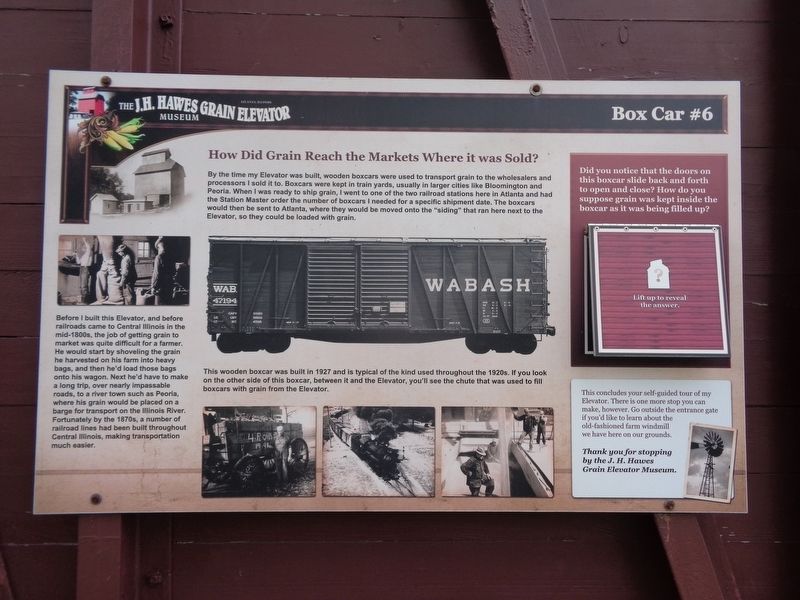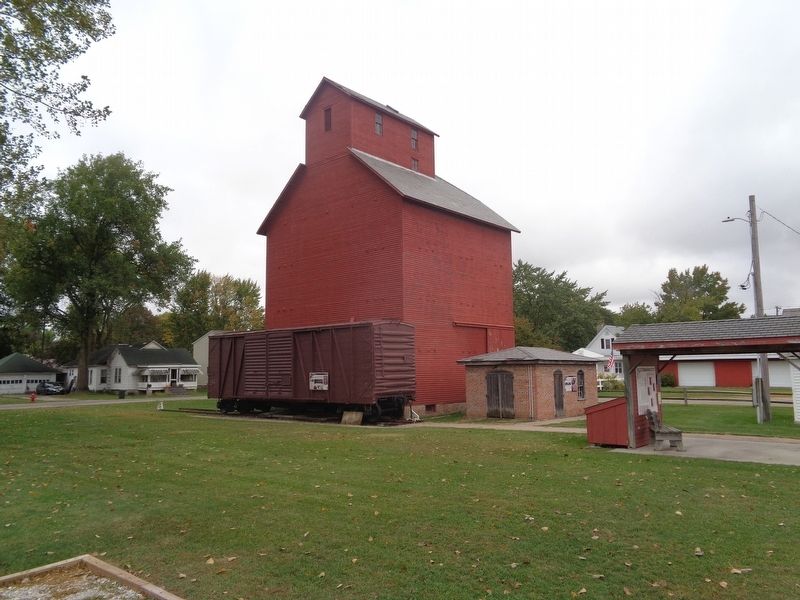Atlanta in Logan County, Illinois — The American Midwest (Great Lakes)
Box Car #6
The J.H. Hawes Grain Elevator Museum
By the time my Elevator was built, wooden boxcars were used to transport grain to the wholesalers and processors I sold it to. Boxcars were kept in train yards, usually in larger cities like Bloomington and Peoria. When I was ready to ship grain, I went to one of the two railroad stations here in Atlanta and had the Station Master order the number of boxcars I needed for a specific shipment date. The boxcars would then be sent to Atlanta, where they would be moved onto the "siding" that ran here next to the Elevator, so they could be loaded with grain.
Before I built this Elevator, and before railroads came to Central Illinois in the mid-1800s, the job of getting grain to market was quite difficult for a farmer. He would start by shoveling the grain he harvested on his farm into heavy bags, and then he'd load those bags onto his wagon. Next he'd have to make a long trip, over nearly impassable roads, to a river town such as Peoria, where his grain would be placed on a barge for transport on the Illinois River. Fortunately by the 1870s, a number of railroad lines had been built throughout Central Illinois, making transportation much easier.
This wooden boxcar was built in 1927 and is typical of the kind used throughout the 1920s. If you look on the other side of this boxcar, between it and the Elevator, you'll see the chute that was used to fill boxcars with grain from the Elevator.
Did you notice that the doors on this boxcar slide back and forth to open and close? How do you suppose grain was kept inside the boxcar as it was being filled up?
(under flap:)
The sliding door on the boxcar would first be opened up all the way. As grain flowed out of the chute into the boxcar, a long wooden board about 2 feet high would be nailed across the bottom of the door opening, inside the boxcar. As grain rose inside the boxcar, another board would be put on top of the first one and nailed into place. This process continued with more boards, until the doorway was filled in and the boxcar was full of grain.
This concludes your self-guided tour of my Elevator. There is one more stop you can make, however. Go outside the entrance gate if you'd like to learn about the old-fashioned farm windmill we have here on our grounds.
Thank you for stopping by the J.H. Hawes Grain Elevator Museum.
Erected by J.H. Hawes Grain Elevator Museum.
Topics. This historical marker is listed in these topic lists: Agriculture • Industry & Commerce • Railroads & Streetcars. A significant historical year for this entry is 1927.
Location.
40° 15.65′ N, 89° 14.04′ W. Marker is in Atlanta, Illinois, in Logan County. Marker can be reached from 1st Street south of NW Race Street. Touch for map. Marker is at or near this postal address: 199-293 SW 2nd St, Atlanta IL 61723, United States of America. Touch for directions.
Other nearby markers. At least 8 other markers are within walking distance of this marker. Engine House #5 (a few steps from this marker); Welcome #1 (a few steps from this marker); Scale House #2 (a few steps from this marker); The J.H. Hawes Grain Elevator Museum (within shouting distance of this marker); J.H. Hawes Grain Elevator (within shouting distance of this marker); Atlanta Public Library-Museum (about 500 feet away, measured in a direct line); Bushnell Grist Mill (about 500 feet away); Library Clock Tower (about 600 feet away). Touch for a list and map of all markers in Atlanta.
More about this marker. This is the last of six markers that are part of the self-guided tour at the J.H. Hawes Elevator Museum. All are told from the narration of how Mr. Hawes would have put it. (#3 and #4 are indoors)
Credits. This page was last revised on December 22, 2020. It was originally submitted on December 22, 2020, by Jason Voigt of Glen Carbon, Illinois. This page has been viewed 109 times since then and 6 times this year. Photos: 1, 2. submitted on December 22, 2020, by Jason Voigt of Glen Carbon, Illinois.

